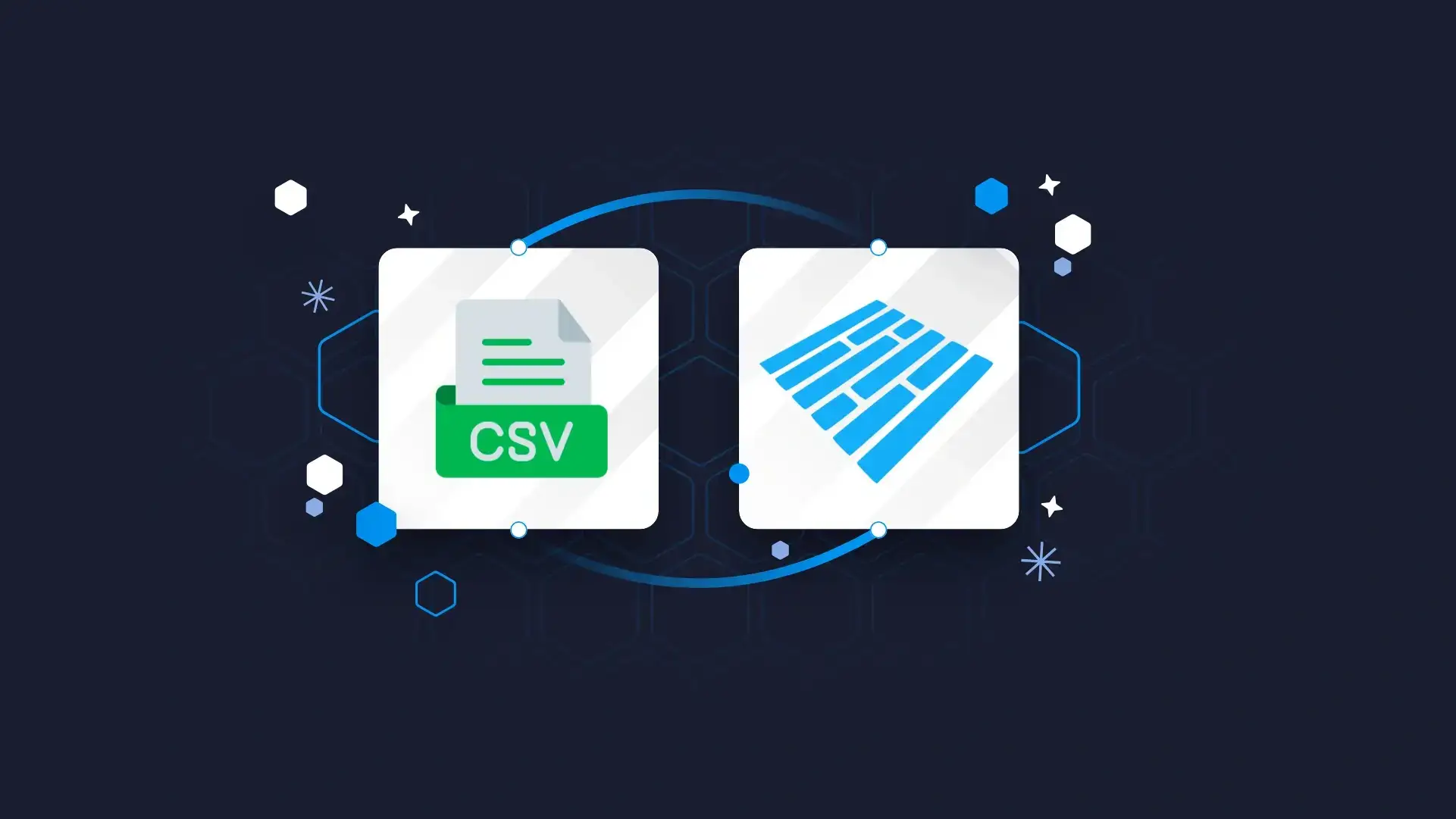In today’s data-driven landscape, the way we store and manage data can significantly impact both efficiency and decision-making processes. While CSV files have long been the go-to format for quick data dumps and simple storage, they come with inherent drawbacks that can hinder performance and data integrity. Enter Parquet—a robust, efficient, and versatile data storage format that is rapidly becoming the new gold standard.
This blog post will delve into why your team should consider making the switch from CSV to Parquet, covering everything from performance issues to compatibility across various tech stacks.
Key Takeaways
Navigating the complexities of data storage formats can have a profound impact on your business efficiency and data integrity.
This blog post aims to make the case for transitioning from CSV to Parquet, a versatile and efficient file format well-suited for today’s diverse tech stacks.
We’ll explore the limitations of CSVs, dive into the advantages of Parquet, and outline high-impact use cases that can benefit from this change.
Whether you’re dealing with large datasets, intricate data pipelines, or cross-team collaboration, Parquet offers a sustainable solution.
By the end, you’ll have the insights needed to make an informed decision and elevate your data storage strategy.
Table of Contents
- Key Takeaways
- Why CSVs are Problematic
- The Parquet Alternative
- Cross-Platform Compatibility and the Parquet-Arrow Synergy
- High-Impact Use Cases for Switching to Parquet
- A Cost-Benefit View
- How to Make the Transition
- Take the Leap: Elevate Your Data Game with Parquet Today
Why CSVs are Problematic
The allure of CSV files often lies in their illusion of simplicity—a basic, readable format that appears easy to create, read, and manipulate.
However, this surface-level ease masks a range of issues that can seriously hamper your data operations. Performance bottlenecks are common when handling large CSV files, leading to delays in data ingestion or analytics tasks.
Additionally, CSVs require the whole file to be read even when you only need a subset of the data, wasting valuable computational resources. The lack of type safety and native data integrity checks can also make CSVs a breeding ground for errors and inconsistencies, from date-time formatting challenges to ambiguous delimiter usage. These issues not only complicate data handling but can also introduce significant risks and inefficiencies into your data pipelines.
Wondering how to build high-performance R Shiny apps? Check out this guide on Building Performant R Shiny Apps with Database Indexing and Normalization.
The Parquet Alternative
While CSVs may be deceptively simple, Parquet offers a more robust and efficient alternative that transcends the scale of your data.
Designed for performance and flexibility, Parquet employs a columnar storage format, enabling better data compression and allowing for selective reading of specific columns—key advantages that result in faster, more efficient data operations.
Furthermore, Parquet is schema-aware, providing a layer of type safety and data integrity that is notably absent in CSVs.
The format is also well-supported across multiple programming languages and platforms, including Python, R, Julia, and DuckDB, making it a highly versatile choice for data storage. Whether your datasets contain a thousand rows or a thousand million rows, Parquet ensures you’re getting the most out of your data, without the drawbacks and limitations associated with CSVs.
Cross-Platform Compatibility and the Parquet-Arrow Synergy
In an increasingly diverse technology landscape, data interoperability is more critical than ever. This is where Parquet, with its deep integration with Apache Arrow, stands out.
Apache Arrow serves as a cross-language development platform for in-memory data, enhancing Parquet’s ability to work seamlessly across Python, R, Julia, and DuckDB, among others.
Harness the power of Apache Arrow for your R Shiny dashboards – our comprehensive guide reveals key strategies!
The result? A file saved in Parquet from any of these platforms will be read consistently in all the others, thereby eliminating technology silos and promoting better data collaboration.
While CSVs can be compressed to save space, they lose their hallmark ‘human readability,’ complicating manual inspection and debugging processes.
In contrast, Parquet files maintain their integrity and structure irrespective of the programming environment. To illustrate the point further, consider the table below comparing key attributes of CSV and Parquet.
| Feature | CSV | Parquet |
| Storage Efficiency | Moderate | High |
| Human-Readable | Yes | No |
| Type Safety | No | Yes |
| Columnar Read | No | Yes |
| Cross-Platform Consistency | Limited | Strong |
| Compression | Possible | Native |
High-Impact Use Cases for Switching to Parquet
When contemplating a switch from CSV to Parquet, the immediate question that arises is: where will this transition bring the most gains? The answer lies in a myriad of use cases that can benefit significantly from Parquet’s advantages.
- Large Datasets: Whether you’re in life sciences, e-commerce, finance, or even academic research, Parquet’s superior storage efficiency and read/write speed make it a natural choice for managing large datasets.
- Data Pipelines: Ensuring data integrity and reducing error propagation becomes easier with Parquet’s type safety features, making it particularly valuable in complex data pipeline architectures.
- Life Sciences Applications: The need for efficient, error-free data storage is as vital in life sciences as in any other field. Parquet’s compatibility with pipeline tools like Nextflow adds another layer of utility, facilitating efficient data exchange in bioinformatics and genomics workflows.
- Multi-platform Environments: Organizations employing a variety of programming languages and data processing tools will find Parquet’s cross-platform capabilities invaluable for technical interoperability. No more NA vs NaN vs #N/A vs NotAvailable problems.
- Cross-Team Collaboration: Parquet eliminates the friction caused by different teams relying on disparate tools like Excel, R, or various BI platforms. Its universal readability ensures that data is interpreted consistently, thereby fostering efficient and accurate collaboration between teams.
By identifying the scenarios where Parquet’s strengths can be most beneficial, organizations can strategize their transition more effectively and maximize their data operation efficiencies.
A Cost-Benefit View
While transitioning from CSV to Parquet may require an initial investment in changing data storage practices and perhaps training your team, the long-term advantages often far outweigh the costs.
Here’s a quick rundown:
- Collaboration: The ability to read Parquet files universally across multiple platforms and tools can reduce friction between teams, enabling more efficient cross-team projects and perhaps even reducing the need for specialized personnel.
- Data Integrity: Reducing the risk of data errors and ensuring type safety can lead to more reliable analytics and fewer costly mistakes.
- Operational Efficiency: Time saved on reading data, especially in real-time analytics or data pipelines, can translate into operational efficiencies, enabling quicker decision-making and problem-solving.
- Storage Costs: Parquet’s efficient compression algorithms can significantly reduce the amount of storage needed, leading to direct cost savings on cloud or on-premise storage solutions.
- Performance Gains: Faster read and write operations not only save time but also reduce computational resource usage, thus saving money. Not to mention saving analysts from frustration when they have to wait seconds or minutes for a dataset to load.
- Strategic Gains: By switching to Parquet, organizations can position themselves as forward-looking and technically sound, gaining a competitive edge.
Balancing these tangible and strategic benefits against the initial setup costs provides a compelling argument for making the switch.
How to Make the Transition
Initiating a switch from CSV to Parquet needn’t be a daunting task. Start by identifying datasets or pipelines where the change would bring immediate benefits, such as those requiring frequent reads or handling large volumes of data.
Next, opt for a phased approach: Begin by converting a subset of your data to Parquet and measure the performance gains and cost savings.
Tools like pandas/polars for Python, readr/arrow for R, or even DuckDB can assist in easy conversion between CSV and Parquet formats.
Also, educate your teams on Parquet’s benefits and functionalities, perhaps through a pilot project, to ease any transition fears. Over time, as the organization becomes comfortable and sees measurable improvements, gradually expand the scope of your transition.
Take the Leap: Elevate Your Data Game with Parquet Today
Time waits for no one, and in the fast-paced world of data, falling behind is not an option. With the compelling benefits of Parquet, the decision to switch should be easier than ever. If you’re looking to supercharge your RShiny dashboards or maximize your data operation efficiencies, now is the time to act.
At Appsilon we specialize in creating high-performance RShiny dashboards that integrate seamlessly with Parquet, offering you the ultimate blend of speed, efficiency, and data integrity.
Don’t let outdated data storage formats hold you back. Take the first step towards a more robust data ecosystem by contacting us today.


